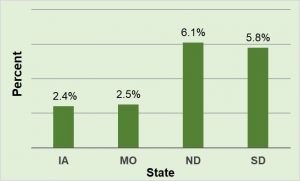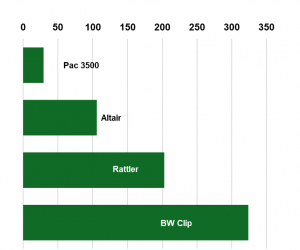Interested in funding your efforts to keep farmers, workers, and their families safe? Apply for a GPCAH $30,000 pilot grant award today.
The Great Plains Center for Agricultural Health (GPCAH) is now accepting applications for new agricultural health and safety research, prevention, intervention, community outreach, and translation projects that will have lasting impacts on the safety and health of farmers and agricultural workers.
“This year we are especially interested in topics related to mental health, sleep deprivation, safe transport and handling of commodities like grain and hay, and slips, trips, and falls prevention,” said Fred Gerr, GPCAH Deputy Director. “In addition to academic investigators, we strongly encourage applications from community organizations and non-academic health and safety professionals who emphasize practical approaches to preventing agricultural injury and illness.”
The pilot grant program anticipates funding up to four projects of 12 to 18 months duration. Applications are open to individuals or groups from Iowa, Illinois, Kansas, Minnesota, Missouri, North Dakota, Nebraska, South Dakota, and Wisconsin. Others may apply provided the topic is relevant to upper Midwest communities.
Applications will be accepted until July 1, 2019, and will be reviewed for responsiveness and potential for agricultural safety and health impact. Awards will be available October 1, 2019.
Questions? Email Jenna-gibbs@uiowa.edu or call (319) 335-4405.

Current GPCAH Pilot Grant awardee Amanda Holmstrom, PhD, and her team at Michigan State University are using their GPCAH funding to study a text messaging-based mental health intervention on smartphones that may help farmers overcome multiple barriers to accessing information about stress and coping strategies.
For more information visit http://bit.ly/2xGoAcu.
Press Release
FOR IMMEDIATE RELEASE: March 19, 2019
CONTACT: Jenn Patterson, MLitt, GPCAH Communications Coordinator
Jennifer-j-patterson@uiowa.edu, 319-335-4026

Remember: No one can take your place
Press release: “No One Can Take Your Place” is theme of Ag Safety Awareness Program Week (March 4-10)
Date: March 2, 2018
Across the country, county and state Farm Bureaus are making safety a priority through the Agricultural Safety Awareness Program. Next week (March 4-10) has been designated as Agricultural Safety Awareness Week. U.S. Agricultural Safety and Health Centers will join Farm Bureau in promoting the week with its theme “No One Can Take Your Place.”
A different safety focus will be highlighted by the Farm Bureau and U.S. Ag Centers each day of the week:
Monday, March 5 – Hearing Protection
Tuesday, March 6 – Respiratory Protection
Wednesday, March 7 – Impaired Driving
Thursday, March 8 – Fire Safety
Friday, March 9 – General Health
During this week and throughout the year, both the Farm Bureau and U.S. Ag Centers partner to encourage farmers to make safety a priority on the farm.
“We are pleased to partner with Farm Bureau during Agricultural Safety Awareness Week,” said Brandi Janssen, Outreach Co-Director of the Great Plains Center for Agricultural Health at the University of Iowa. “Agricultural safety continues to be a sound investment for farmer and ranchers. Focusing on safety and health on the farm helps save lives and protect our most important resources in agriculture, our farmers and farmworkers.”
The Agricultural Safety Awareness Program is a part of the Farm Bureau Health and Safety Network of professionals who share an interest in identifying and decreasing safety and health risks. For more information and resources, visit the ASAP Facebook page or the Great Plains Center Website. Throughout the week, several free webinars on agricultural safety topics will also be announced via social media.
Visit the Centers’ YouTube channel for new content and fresh ideas about how to stay safe while working in agriculture, forestry, and fishing. Join the movement to keep farms safe and share your own safety messages on social media using the hashtags #KeepFarmsSafe, #ASAP18 and #USAgCenters.
The 11 U.S. Agricultural Safety and Health Centers (www.cdc.gov/niosh/oep/agctrhom.html) are funded by the National Institute for Occupational Safety and Health.
Farmers operating equipment on roads should be cautious of alcohol-impaired drivers, especially during nighttime work.
Press release: Three quarters of farm equipment related crashes involving alcohol result in injury or death.
Date: December 14, 2017
Link to article: Prevalence of alcohol impairment and odds of a driver injury or fatality in on-road farm equipment crashes.
Rural roads can be hazardous for drivers due to poor roadway conditions, high travel speeds, and frequent encounters with farm equipment and other slow moving vehicles. A recent five-year study published in the December edition of Traffic Injury Prevention identified more than 60 alcohol-related crashes involving farm equipment in four Midwestern states. “We found that the passenger vehicle drivers were more often impaired than the farmers operating their equipment. This is important because these impaired drivers may be slower to recognize and react to farm equipment, and more likely to misjudge the differences in speed of the equipment on the roadway,” said Karisa Harland, the lead investigator.
The team of researchers from the University of Iowa and University of Minnesota found that the percentage of alcohol-impaired crashes involving farm equipment varied by state. North Dakota and South Dakota, respectively, had the highest proportions of alcohol-impaired driver crashes when compared to the other states. Most crashes resulted from the impaired passenger vehicle driver rear-ending or running head-on into the farm equipment.
Not surprisingly, a greater percentage of the alcohol-impaired crashes occurred at night and on weekends. “We know that during critical times of the year, farmers have to work around the clock. Overall, the proportion of alcohol impairment in crashes involving farm equipment is low—less than three percent,” said Harland. “However, when these crashes occur they can be devastating, because most of them result in an injury or death. There is a continued need for educating all road users about alcohol use while driving and the appropriate ways to interact with farm equipment on roads.”

The percentage of alcohol-impaired driver crashes were different for each state. North Dakota and South Dakota had the highest percentages of these types of crashes.
Article DOI: 10.1080/15389588.2017.1407924
In livestock production, not all gas monitors are the same.
Press release: Study finds that routine care of low cost hydrogen sulfide monitors is needed to save lives.
Date: November 21, 2017
Link to article: Evaluation of low cost hydrogen sulfide monitors for use in agricultural production.
Last fall, livestock producers in Iowa, Illinois, and Wisconsin were alerted to the dangers of hydrogen sulfide gas following a series of cattle fatality incidents during manure handling activities. Hydrogen sulfide is an important manure pit gas, and it is released during agitation and manure pumping. Many livestock workers are familiar with the gas’s “rotten egg” odor.
Some producers are starting to wear low cost direct readying gas monitors to provide warning alarms when hydrogen sulfide gases are released and become dangerous to life and health. Hydrogen sulfide monitors are available from many manufacturers and are recommended for use during manure handling operations. Leaving the area when a gas monitor alarms can save lives.

The number of days until a first failure of personal hydrogen sulfide monitors stored in livestock buildings.
Researchers at the University of Iowa compared the performance of four easy to use, low-cost hydrogen sulfide monitors in an article published in the Journal of Agricultural Safety and Health. Although each gas monitor had different features, all of the monitors had a low and high alarm to alert the user of dangerous hydrogen sulfide levels. In addition, all monitors were advertised as good for at least two-years in the field. The researchers tested each monitor’s performance over time, simulating what they might be exposed to over one year of use in a livestock environment.
Performance of monitors declined over time. All of these monitors showed signs of reduced performance as the study progressed. “When we exposed these monitors hydrogen sulfide at levels that would be seen on the farm, the time it took for the monitor to signal an alarm increased,” said Dr. Renée Anthony. “This would be a problem if someone wearing the monitor was not warned of hazardous concentrations quickly.”
Not all manufacturers recommend performing bump tests on gas monitors. However, the results of this study recommend that you should. The “bump test” simply requires delivering a known concentration of gas to the monitor and then checking: Does the alarm go off? Does it alarm quickly (<15 seconds)? If the monitor displays a gas level– does it match the one on your gas bottle? “Bump testing is important for workers who plan to perform high-risk activities like agitating or pumping manure and pressure washing”, said Anthony. “If your monitor doesn’t display the gas level, it is the only way to know if the sensor still able to detect hydrogen sulfide.”
- Information for how to perform a bump test is available HERE. Producers should plan ahead and test their monitors before using them in potentially hazardous situations.
- For questions on gas monitors or how to perform bump tests, please contact the Great Plains Center for Agricultural Health at CPH-GreatPlainsCenter@uiowa.edu.
